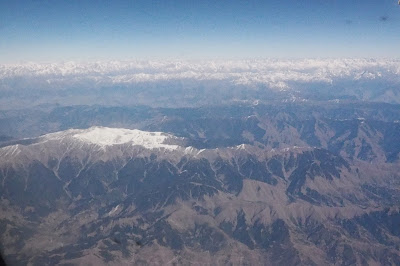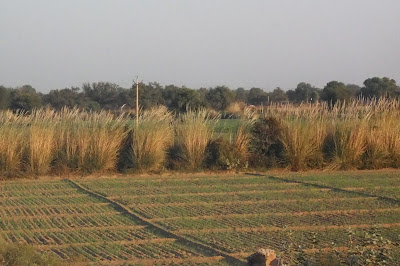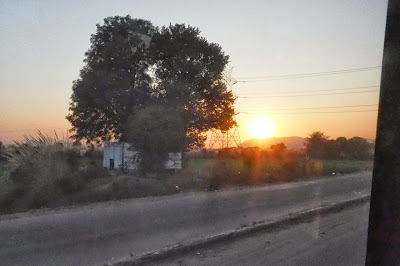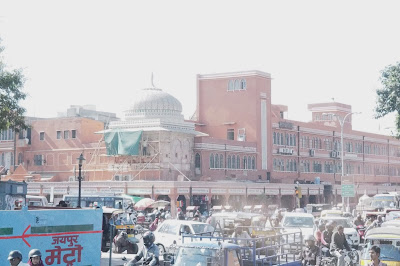After Gulmarg, we left Srinagar for Jaipur, the capital of the state of Rajastan.

and were given a last chance to look at the snow capped Himalayas.
The lower portions of the mountains were covered by fogs or clouds.
Some of the mountains we flew past.
One could see that even at such heights, the less windswept parts of the mountain sides were covered with some vegetation.
Ranges after ranges of mountains.
Peaks after peaks
and collections after collection of snow
As we moved south, there was less and less snow.
But the more distant mountain tops still kept their white caps.
We arrived at the New Delhi Airport again
The arrival hall
A painting at the arrival hall: a very Indian face.
After getting off the plane, we were driven to our hotel by another coach. We passed through this roadside stall. The young man was lucky. Nearly all stuffs sold out.
This is still the way many Indian women carry their stuffs.

Like the Japanese, some Indians use the roadside as his public latrine with total unconcern.
One can see cattle running around everywhere on the roads.
For some reasons, Indians like to cover the side and front of their trucks with all kinds of pictures
if not the sides, then the front of their vehicles.
December 4 is supposed to be election day. This truck was fitted out with loud speakers for soliciting votes as part of the relevant party's political campaign.
We passed through miles and miles of fields like this.
It was getting dark.
Some flowers at a rest stop at a new villa for Europeans playing hang gliding.
The "Kamasutra" in the counter for books at the flying club/restaurant shop.
The Kamasoutra in French.
An outdoor version.
a ladies version.
A completely illustrated version.
But there were also religious books on sale too.
The sun was sinking fast
but we were still on our way to our hotel in Jaipur.
It seems that some Indians don't really care if they sleep in the full view of the public.
The women appear to enjoy wearing bright colors with intricate patterns whilst the men prefer more simplicity.
They do not appear to pay much attention on shop display.
There're still many of such tricycle-taxis driven by human leg-power.
Everywhere we went, we found these motorized tricycle-taxis.
Many simply lay on the ground whatever it is they wish to sell.
Some tricycles appear to be used also for transporting some loads which appear totally disproportionate to their flimsy construction.
Everywhere we went, we found dirt on the roadside. It appears that "public" may mean "public rubbish dump"
Seeing this man sitting within such a cramped space in his push cart, I begin to understand why Indians are such expert yoga contortionists.
This appears to be a fire engine
There does not appear to be any traffic regulations and if there are, no one appears to be bothered by them. You see vehicles going in both directions at the same time.
A little tent on a pole or two, and you're all set for business.
Or even just a tray, or trolley or just a bit of space on the ground.
Everything seems to over-flow or over-extend their original boundaries.
Lady vendors/housewives seem unwilling to abandon their long colorful saris even at the marketplace.
Spring opinion, garlic, potatoes, dates, fruits etc are placed on whatever trays, boxes they happen to have.
Old newspaper or pages from a magazine are turned into make-shift sunshades/hats.
4 different women and 4 different kinds of dress in 4 different colors and patterns.
Oranges, bananas, pumpkins and other fruit on different colored crates.
A man carrying a heavy load on his shoulders in front of another fruit stall.
6 muslim women going the same way, an old lady being helped to walk.
A roadside unmetered car park. I don't recall having one single metered car park there.
People standing, looking, waiting.
Indian biscuits, cakes, candies on sale.
A converted trolley with a hood for selling snacks.
A piece of string tied to two trees and you have a display line for beautiful fabric
or dresses, pants etc.
Public spaces are seldom wasted.
A a dumb-bell wicker stand and a few fruits and you'll have your daily bread or plate of rice.
The City Palace combines Hindu and Mughal architectural features.

One of the old city gates to the City Palace.


Another marble gate with typical Islamic floral patterns



Diwan-I-Khas was a private audience hall of the Maharajas. To its left is the king's residence.
One of the two huge silver Gangajelies.

The hall has marble pillars and floor and has beautiful scalloped arches decorated with floral patterns.
The intricate built in window shades which allows both air and sunshine through of the private audience hall.
A couple of lovers visiting the palace posing for me.
A group of primary students led by their teacher for a tour of the palace grounds.

An Indian lady was sitting at one corner of the hall doing hand painting for visitors for $3 USD

Hard at work..

Another pattern.


Another part of the palace.

One of the peacocks at the lotus gate, representing autumn, dedicated Lord Vishnu.
This is the Northwest Green Gate, also called the Leheriya (meaning: "waves") gate, its green colour suggestive of spring and dedicated to Lord Ganesha.

Marble sculpture

Summer

Summer is represented by roses

The face of the sun is different on the lotus gates
A close up of one of such sculptures in marble

Autumn
Beautiful arches to the King's private residence


A guard resting on the floor. What's is he thinking about?
After a good night's sleep, we were on our way again for a brief tour of Jaipur.Jaipur, with a population of more than 3 million, is the capital and
largest city in Rajasthan. It was first rebuilt in 1727 by
Maharaja Sawai Jai Singh II (1693-1744) as India's first planned city
and is one of component cities of the so-called "tourist Golden
Triangle" of Delhi- Agra-Jaipur. It's often called the Pink City because
in 1876, when it was still a British colony, the buildings of the
entire city was painted this color, traditionally the color of
hospitality, by Maharaja Ram Singh to welcome the royal visit of the
Prince of Wales (later King Edward VII). But before that some of its
buildings were already of that color, the color of the red sandstones of
Mughal architecture. But even today, all buildings in the old city are
required by municipal law to preserve the tradition and be painted pink.
The city got its name from its founder, Maharaja Jai Singh II the great warrior and astronomer whose ancestry can be traced back to the Kucchwaha Rajput clan which came first to power in the 12th century. They fought for control of the Rajastan with the Sisodia Rajputs who ruled from Mewar with the help of the Mughals. Jai Singh II was first ousted from power in a succession dispute but allied himself with other Jaiput states against the Mughals and eventually won and annexed both the Mewar (Udaipur) and Marwar (Jodhpur) and started ruling from the famous Amber Fort/Palace some 11 kilometers from present day Jaipur. After he got control of the city, he started rebuilding it along scientific principles according to the ancient Indian architectural manual called Shilpa Shastra with the help of a famous Bengalese chief architect,Vidhyadhar Bhattacharya. The old city was divided by 34-meter wide streets 34 meters into six sectors and each urban quarter is further divided by networks of gridded streets. Five such sectors wrap around the east, south, and west sides of a central City Palace sector, with a sixth sector immediately to the east. The Palace City encloses the Hawa Mahal palace complex, formal gardens, and a small lake.It remains one of India’s best planned pre-modern cities.
The city got its name from its founder, Maharaja Jai Singh II the great warrior and astronomer whose ancestry can be traced back to the Kucchwaha Rajput clan which came first to power in the 12th century. They fought for control of the Rajastan with the Sisodia Rajputs who ruled from Mewar with the help of the Mughals. Jai Singh II was first ousted from power in a succession dispute but allied himself with other Jaiput states against the Mughals and eventually won and annexed both the Mewar (Udaipur) and Marwar (Jodhpur) and started ruling from the famous Amber Fort/Palace some 11 kilometers from present day Jaipur. After he got control of the city, he started rebuilding it along scientific principles according to the ancient Indian architectural manual called Shilpa Shastra with the help of a famous Bengalese chief architect,Vidhyadhar Bhattacharya. The old city was divided by 34-meter wide streets 34 meters into six sectors and each urban quarter is further divided by networks of gridded streets. Five such sectors wrap around the east, south, and west sides of a central City Palace sector, with a sixth sector immediately to the east. The Palace City encloses the Hawa Mahal palace complex, formal gardens, and a small lake.It remains one of India’s best planned pre-modern cities.
It seems that some Indians don't really care if they sleep in the full view of the public.
Many of them appear to find it perfectly OK to sit around doing little or nothing all day.
The women appear to enjoy wearing bright colors with intricate patterns whilst the men prefer more simplicity.
They do not appear to pay much attention on shop display.
There're still many of such tricycle-taxis driven by human leg-power.
Everywhere we went, we found these motorized tricycle-taxis.
Many simply lay on the ground whatever it is they wish to sell.
The streets are always filled with people lorries, vans, motor cycles, motor tricycles, bicycles and pedestrians vy with each other for their share of road space.
Some tricycles appear to be used also for transporting some loads which appear totally disproportionate to their flimsy construction.
Everywhere we went, we found dirt on the roadside. It appears that "public" may mean "public rubbish dump"
Seeing this man sitting within such a cramped space in his push cart, I begin to understand why Indians are such expert yoga contortionists.
This appears to be a fire engine
There does not appear to be any traffic regulations and if there are, no one appears to be bothered by them. You see vehicles going in both directions at the same time.
A little tent on a pole or two, and you're all set for business.
Or even just a tray, or trolley or just a bit of space on the ground.
Everything seems to over-flow or over-extend their original boundaries.
Lady vendors/housewives seem unwilling to abandon their long colorful saris even at the marketplace.
Spring opinion, garlic, potatoes, dates, fruits etc are placed on whatever trays, boxes they happen to have.
Old newspaper or pages from a magazine are turned into make-shift sunshades/hats.
4 different women and 4 different kinds of dress in 4 different colors and patterns.
Oranges, bananas, pumpkins and other fruit on different colored crates.
A man carrying a heavy load on his shoulders in front of another fruit stall.
6 muslim women going the same way, an old lady being helped to walk.
A roadside unmetered car park. I don't recall having one single metered car park there.
People standing, looking, waiting.
Indian biscuits, cakes, candies on sale.
A converted trolley with a hood for selling snacks.
A piece of string tied to two trees and you have a display line for beautiful fabric
or dresses, pants etc.
Public spaces are seldom wasted.
A a dumb-bell wicker stand and a few fruits and you'll have your daily bread or plate of rice.
This is the famous 5-storey sandstone Hawa Mahal (Palace of Breeze), built in 1799 as part of City Palace. In fact, it's an extension of the royal Zenana (women) chamber. Its 950 tiny windows are there to enable royal ladies to observe everyday life in the
street below without being seen. The breeze (or hawa in Hindi)
circulates through these windows and gives the palace its name.
This is a corner of the City Palace facing a busy street market.The City Palace, in the central-northeast part of the Jaipur old city, is laid in a grid pattern with wide avenues and include a complex of several palaces, pavilions, gardens and temples the most visited of which are the
Chandra Mahal, Mubarak Mahal, Mukut Mahal, Maharani's Palace, Shri
Govind Dev Temple and the City Palace Museum.
The City Palace combines Hindu and Mughal architectural features.

One of the old city gates to the City Palace.

This is the Tripolia Gate (triple
gate) one of the entry gates to the City Palace. Originally, this was was reserved for entry into the palace only to the royal family and ordinary people could enter the only through the Virendra Pol which led to the Mubarak Mahal
and the Udai Pol or the Atish Pol (Stable Gate).

Another marble gate with typical Islamic floral patterns

This is the Maharani's Palace, part of the City Palace. Originally the queen's residence, it has been now been converted into an arms museum where various arms used by the Indian kings in some of their former campaigns are displayed, including some used in the
15th century. The ceiling of this chamber has unique frescoes,preserved through the use of the dust of semiprecious stones. A particular
weaponry on display is the scissor-action dagger, which when thrust into
an enemy's body is said to disembowel the victim, on its withdrawal. Other artefacts on display include swords with pistols attached to
it, the sword presented by Queen Victoria to Maharaja Sawai Ram Singh
(1835–80) inlaid with rubies and emeralds, guns serving as
walking sticks.

Another view of the Maharani Palace from a corner of the first courtyard, Behind it the Mubarak Mahal, or the Auspicious
Palace which contains the textile section of the Maharaja Sawai Man Singh II
Museum. But we did not have time to visit it.

Diwan-I-Khas was a private audience hall of the Maharajas. To its left is the king's residence.
This is part of the pink colored a marble
floored hall of the Diwan-I-Khas. Located between the armament museum and the art gallery.
Displayed there are two 5.2 feet high sterling silver vessels, each with capacity of 4000 litres and weighing 750
lb, made from 14000 melted silver coins
without soldering. They are officially recorded by the Guinness Book of
World Records as the world's largest sterling silver vessels. They were specially made by Maharaja Sawai Madho Singh II, who was a
highly pious Hindu, to carry the water of the Ganges to drink on his
trip to England in 1901 (for Edward VII's coronation) as he was finicky
about committing religious sin by consuming the English water. Hence,
the vessels are named as Gangajelies or Ganges-water urns. There are a
number of crystal chandeliers hanging from the ceiling there.
One of the two huge silver Gangajelies.

The hall has marble pillars and floor and has beautiful scalloped arches decorated with floral patterns.
The intricate built in window shades which allows both air and sunshine through of the private audience hall.
A couple of lovers visiting the palace posing for me.
A group of primary students led by their teacher for a tour of the palace grounds.

An Indian lady was sitting at one corner of the hall doing hand painting for visitors for $3 USD

Hard at work..
The final product. She uses some local herbs, flour and coloring. It takes several hours to dry. So the ladies had to take care not to ruin the pattern. We're told that they keep their pattern for a number of days and can survive normal showers. After the first girl had it done, two other girls in our group wanted theirs to be done too!

Another pattern.

This is the Chandra Mahal or the Moon Palace, the king's residence at the west end of the complex. We're told that the last Maharaja
of Jaipur to rule from the Chandra Mahal palace was Khaggi KhanaMan Singh
II, the adopted son of Maharaja Madho Singh II but that after
the
Jaipur kingdom merged with the Indian Union in 1949 (after Indian
independence in August 1947) along with other Rajput states of Jodhpur,
Jaisalmer and Bikaner, he was appointed Rajapramukh (the
equivalent of present day State Governor) and later the Indian
Ambassador to Spain. To this day, the palace continues to be used as a royal residence for his descendants. Hence no visits inside are allowed. Each floor of this 7-storeyed palace is given a special name eg. Sukh-Niwas,
Ranga-Mandir, Pitam-Niwas, Chabi-Niwas, Shri-Niwas and Mukut-Mandir or
Mukut Mahal etc. and contains many unique paintings, wall mirrors and
floral decorations. Only its ground floor
is open for visits. There is a museum there which displays the carpets,
manuscripts and other items that belonged to the royal family.
There are four small gates (known as Ridhi Sidhi Pol) to the King's inner court, representing the 4 season: spring, summer, autumn and winter. This is the famous peacock gate for entry into the inner courtyard to the Chandra Mahal Palace, with its screened
balconies and a pavilion at the roof from where a panoramic view of the
city can been seen. It is set amidst well laid out gardens

Another part of the palace.
This is the entrance to Mubarak Mahal, meaning the 'Auspicious Palace'
in a mix of Islamic, Rajput and European architectural styles
in the late 19th century by Maharaja Madho Singh II as reception centre.
It is now a museum for a variety of textiles such as the
royal formal costumes, sanganeri block prints, embroidered shawls,
Kashmiri pashminas and silk saris as part of the Maharaja Sawai Man
Singh II Museum. Here is found a set of voluminous
clothes worn by Sawai Madhosingh I, who was 1.2 metres (3.9 ft) wide and
weighed 250 kilograms (550 lb) but interestingly had 108 wives.

A closer look at the top of the gate with its 5 peacocks.
One of the peacocks at the lotus gate, representing autumn, dedicated Lord Vishnu.
This is the Northwest Green Gate, also called the Leheriya (meaning: "waves") gate, its green colour suggestive of spring and dedicated to Lord Ganesha.

Marble sculpture

Summer

Summer is represented by roses

The face of the sun is different on the lotus gates
A close up of one of such sculptures in marble

Autumn
Beautiful arches to the King's private residence
This is the The 'Diwan-E-Aam' (Sabha Niwas) or the 'Hall of
Public Audience' with its ceiling painted in
rich red and gold colours and is now an art gallery exhibiting exquisite miniature paintings (of
Rajastahni, Mughal and Persian art), ancient texts, embroidered rugs,
Kashmir shawls and carpets, handwritten original manuscripts of Hindu
Bhagavad Gita., the Hindu "Bible", Its ceiling is richly decorated. Also
displayed inside is the Golden throne (called as Takth-e-Rawal) that
was the seat of the Maharaja during public audience. It was mounted on
an elephant or carried by palanquin bearers during the Maharajas visit
outside the palace. At the entry gateway to the hall, two large
elephants, each made out of single marble rock are on display.

One of the gates.

A guard resting on the floor. What's is he thinking about?












































































沒有留言:
張貼留言